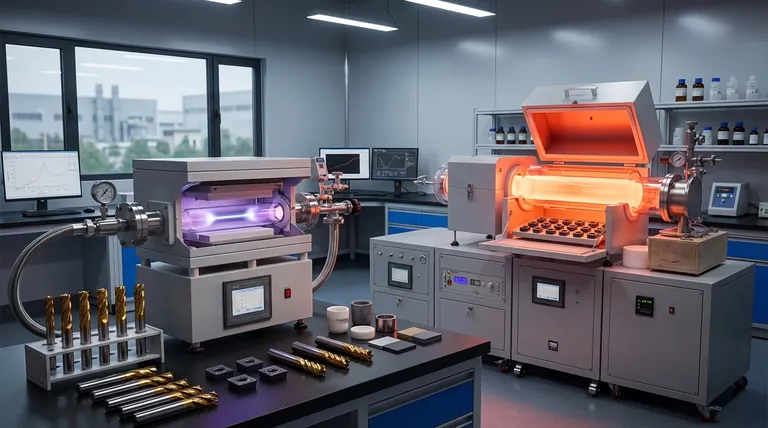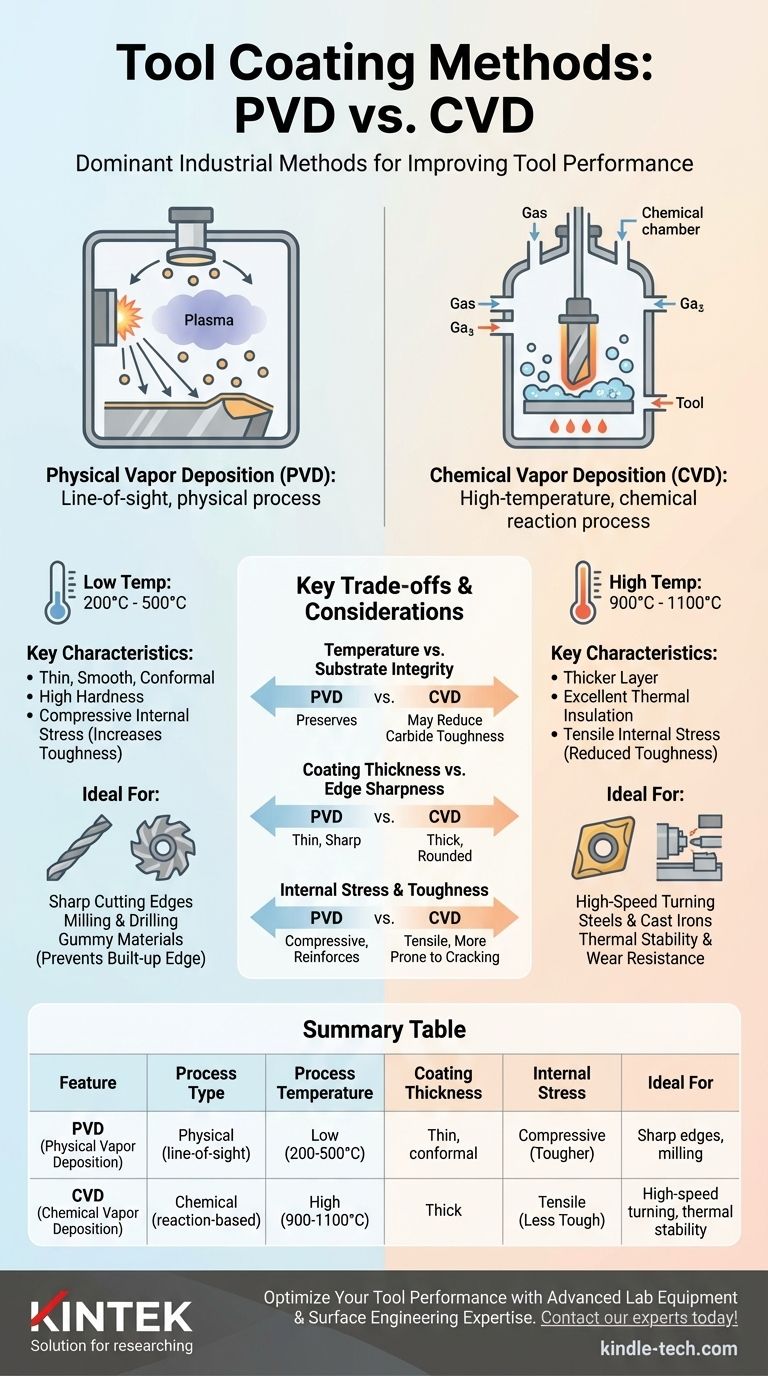The two dominant industrial methods for coating cutting tools are Physical Vapor Deposition (PVD) and Chemical Vapor Deposition (CVD). While both deposit a thin, hard layer of material onto a tool's surface to improve performance, their underlying processes and resulting characteristics are fundamentally different.
The choice between PVD and CVD is not about which is "better," but which is appropriate for the application. PVD is a lower-temperature physical process ideal for sharp, tough tools, while CVD is a high-temperature chemical process that creates thick, heat-resistant coatings for high-speed operations.

Understanding Physical Vapor Deposition (PVD)
Physical Vapor Deposition is a "line-of-sight" process conducted at relatively low temperatures, typically between 200°C and 500°C.
The PVD Process Explained
In a PVD process, a solid coating material is vaporized into a plasma within a vacuum chamber. This vapor is then physically deposited onto the cutting tool's surface, where it condenses into a thin, hard film. Think of it as an atomic-level spray-painting process.
Key Characteristics of PVD Coatings
PVD coatings are very thin, smooth, and have high hardness. Crucially, the process imparts a compressive internal stress to the coating, which helps to increase the tool's toughness and resist cracking.
Ideal Applications for PVD
The low-temperature process does not alter the core properties of the tool substrate, like carbide. This makes PVD ideal for applications requiring sharp cutting edges and high toughness, such as milling, drilling, and machining gummy materials that are prone to built-up edge.
Understanding Chemical Vapor Deposition (CVD)
Chemical Vapor Deposition is a process that relies on a chemical reaction at very high temperatures, usually between 900°C and 1100°C.
The CVD Process Explained
In a CVD process, the cutting tools are placed in a reactor where various gases are introduced. The high heat causes these gases to react and decompose, depositing a layer of the desired coating material onto the tool. This process "grows" the coating on the surface through a chemical bond.
Key Characteristics of CVD Coatings
CVD coatings are significantly thicker than PVD coatings, providing excellent insulation and wear resistance in high-heat situations. However, the process creates a tensile internal stress, which can make the coating more prone to cracking under impact.
Ideal Applications for CVD
The exceptional thermal stability and thickness of CVD coatings make them the preferred choice for high-speed turning operations, particularly in steels and cast irons where a massive amount of heat is generated at the cutting edge.
Key Trade-offs and Considerations
Choosing the correct coating method requires understanding the direct consequences of each process.
Temperature vs. Substrate Integrity
The high heat of the CVD process can reduce the toughness of a carbide substrate. PVD's low-temperature application preserves the substrate's original properties, maintaining its strength and fracture resistance.
Coating Thickness vs. Edge Sharpness
PVD creates a very thin coating that conforms precisely to the tool's geometry, preserving a sharp cutting edge. The thicker CVD coating inherently rounds the cutting edge, which is detrimental for milling but acceptable for some turning applications.
Internal Stress and Toughness
The compressive stress from PVD coatings acts like a reinforcing layer, helping to prevent micro-cracks from propagating through the tool. The tensile stress in CVD coatings can do the opposite, making them less suitable for interrupted cuts.
Making the Right Choice for Your Application
Your machining goal dictates the ideal coating technology.
- If your primary focus is preserving sharp edges for milling, drilling, or threading: PVD is the superior choice due to its low-temperature application and thin, conformal coating.
- If your primary focus is high-speed turning of steel or cast iron: CVD provides the exceptional thermal protection and crater wear resistance needed for these demanding, high-heat operations.
- If your primary focus is toughness and preventing built-up edge in sticky materials: The compressive stress and extreme smoothness of PVD coatings make them the ideal solution.
Understanding the fundamental process differences empowers you to select a tool perfectly matched to your material and machining strategy.
Summary Table:
| Feature | PVD (Physical Vapor Deposition) | CVD (Chemical Vapor Deposition) |
|---|---|---|
| Process Type | Physical (line-of-sight) | Chemical (reaction-based) |
| Process Temperature | 200°C - 500°C (Low) | 900°C - 1100°C (High) |
| Coating Thickness | Thin, conformal | Thick |
| Internal Stress | Compressive (increases toughness) | Tensile (can reduce toughness) |
| Ideal For | Sharp edges, milling, drilling, tough tools | High-speed turning, thermal stability, wear resistance |
Ready to Optimize Your Tool Performance?
Choosing the right coating is critical for maximizing tool life and machining efficiency. KINTEK specializes in advanced lab equipment and consumables for surface engineering and material analysis, helping you validate and select the perfect coating technology for your specific needs.
Our expertise supports R&D and quality control in tool coating applications, ensuring your tools perform at their peak.
Let's discuss your project and find the ideal solution. Contact our experts today!
Visual Guide

Related Products
- Chemical Vapor Deposition CVD Equipment System Chamber Slide PECVD Tube Furnace with Liquid Gasifier PECVD Machine
- Inclined Rotary Plasma Enhanced Chemical Vapor Deposition PECVD Equipment Tube Furnace Machine
- RF PECVD System Radio Frequency Plasma-Enhanced Chemical Vapor Deposition RF PECVD
- Customer Made Versatile CVD Tube Furnace Chemical Vapor Deposition Chamber System Equipment
- Vacuum Hot Press Furnace Machine for Lamination and Heating
People Also Ask
- What are the advantages of PECVD over CVD? Achieve High-Quality Thin Films at Lower Temperatures
- What are the examples of CVD method? Discover the Versatile Applications of Chemical Vapor Deposition
- How plasma is generated in PECVD? A Step-by-Step Breakdown of the Process
- What is the precursor gas in PECVD? The Key to Low-Temperature Thin Film Deposition
- What is the difference between thermal CVD and PECVD? Choose the Right Thin-Film Deposition Method



















